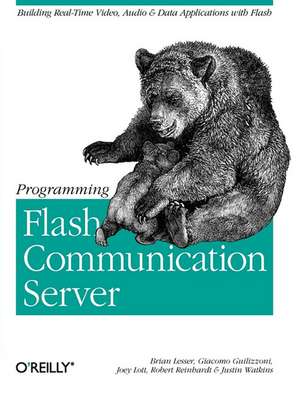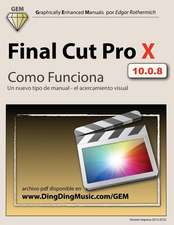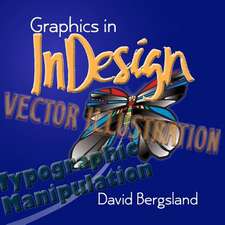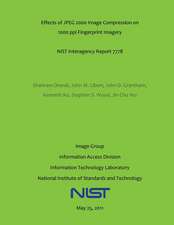Programming Flash Communication Server: O'Reilly Ser.
Autor Robert Reinhardt, Branden Hall, Samuel Wan, Dave Yangen Limba Engleză Paperback – 28 feb 2005
With the advent of Flash Communication Server MX (FCS), Macromedia believes that it's on the edge of a breakthrough in how people think about the Internet. FCS has been designed to provide web developers with the means to add polished interactive audio and video features to their sites, the sort of features that users have come to expect.
Naturally, the process of efficiently integrating rich media into applications, web sites, and web content is a complex one, to say the least. That's where Programming Flash Communication Server factors in. As the foremost reference on FCS, it helps readers understand how FCS can facilitate:
- Video on demand
- Live webcasts
- Video chat and messaging
- Shared desktop conferences
- Live auctions
- Interactive whiteboard presentations
- Workflow collaboration
- Multi-user games
Programming Flash Communication Server gives developers a sorely needed leg up on this potentially intimidating technology. It lets users develop cool web applications ranging from direct dating experiences with real-time video, to pre-recorded corporate presentations, to news services with video and audio, and much more.
At last, the ability to build web sites with rich interactive features--minus the complex downloads and installation hassles--is a reality. And now, with Programming Flash Communication Server from O'Reilly by your side, you can do more quickly and easily than you ever dreamed possible.
Din seria O'Reilly Ser.
- 20%
 Preț: 330.02 lei
Preț: 330.02 lei - 20%
 Preț: 200.96 lei
Preț: 200.96 lei - 20%
 Preț: 135.83 lei
Preț: 135.83 lei -
 Preț: 140.22 lei
Preț: 140.22 lei -
 Preț: 186.15 lei
Preț: 186.15 lei - 20%
 Preț: 140.22 lei
Preț: 140.22 lei - 20%
 Preț: 218.63 lei
Preț: 218.63 lei - 20%
 Preț: 213.02 lei
Preț: 213.02 lei - 20%
 Preț: 171.22 lei
Preț: 171.22 lei - 20%
 Preț: 244.63 lei
Preț: 244.63 lei - 20%
 Preț: 178.14 lei
Preț: 178.14 lei - 20%
 Preț: 136.36 lei
Preț: 136.36 lei - 20%
 Preț: 198.36 lei
Preț: 198.36 lei - 20%
 Preț: 232.48 lei
Preț: 232.48 lei - 20%
 Preț: 246.11 lei
Preț: 246.11 lei - 20%
 Preț: 317.36 lei
Preț: 317.36 lei - 20%
 Preț: 78.44 lei
Preț: 78.44 lei - 20%
 Preț: 191.44 lei
Preț: 191.44 lei - 20%
 Preț: 174.80 lei
Preț: 174.80 lei - 20%
 Preț: 127.64 lei
Preț: 127.64 lei - 20%
 Preț: 197.99 lei
Preț: 197.99 lei - 20%
 Preț: 232.58 lei
Preț: 232.58 lei - 20%
 Preț: 167.52 lei
Preț: 167.52 lei - 20%
 Preț: 259.58 lei
Preț: 259.58 lei - 20%
 Preț: 186.42 lei
Preț: 186.42 lei - 20%
 Preț: 195.20 lei
Preț: 195.20 lei - 20%
 Preț: 180.57 lei
Preț: 180.57 lei - 20%
 Preț: 197.62 lei
Preț: 197.62 lei - 20%
 Preț: 192.00 lei
Preț: 192.00 lei - 20%
 Preț: 236.40 lei
Preț: 236.40 lei - 20%
 Preț: 253.66 lei
Preț: 253.66 lei - 20%
 Preț: 113.47 lei
Preț: 113.47 lei - 20%
 Preț: 214.17 lei
Preț: 214.17 lei - 20%
 Preț: 191.24 lei
Preț: 191.24 lei - 20%
 Preț: 174.44 lei
Preț: 174.44 lei - 20%
 Preț: 286.88 lei
Preț: 286.88 lei - 20%
 Preț: 139.70 lei
Preț: 139.70 lei - 20%
 Preț: 128.92 lei
Preț: 128.92 lei - 20%
 Preț: 280.91 lei
Preț: 280.91 lei - 20%
 Preț: 134.77 lei
Preț: 134.77 lei - 20%
 Preț: 259.38 lei
Preț: 259.38 lei - 20%
 Preț: 170.11 lei
Preț: 170.11 lei -
 Preț: 148.23 lei
Preț: 148.23 lei - 20%
 Preț: 202.27 lei
Preț: 202.27 lei - 20%
 Preț: 243.52 lei
Preț: 243.52 lei -
 Preț: 204.30 lei
Preț: 204.30 lei - 20%
 Preț: 161.70 lei
Preț: 161.70 lei - 20%
 Preț: 163.19 lei
Preț: 163.19 lei - 20%
 Preț: 127.56 lei
Preț: 127.56 lei - 20%
 Preț: 201.90 lei
Preț: 201.90 lei
Preț: 316.66 lei
Preț vechi: 395.82 lei
-20% Nou
60.61€ • 65.86$ • 50.95£
Carte tipărită la comandă
Livrare economică 21 aprilie-05 mai
Specificații
ISBN-10: 0596005040
Pagini: 854
Dimensiuni: 182 x 234 x 41 mm
Greutate: 1.2 kg
Editura: O'Reilly
Seria O'Reilly Ser.
Locul publicării:United States
Notă biografică
Brian Lesser works at Ryerson University as Assistant Director, Application Development and Support in Ryerson's Computing and Communications Services.
Giacomo "Peldi" Guilizzoni is a software engineer working on Macromedia Breeze Live, possibly the most complex Rich Internet Application powered by Flash Communication Server ever built. He has been involved in the FlashCom community since the very beginning and to this day maintains the only FlashCom-centered blog on the Web at http: //wwwpeldi.com/blog.
Joey Lott is a founding partner of The Morphic Group, a Flex and Flash consulting company. At The Morphic Group Joey serves as a technology director, building some of today's most innovative Flex applications and advocating for the use and adoption of agile software development methodologies. He has written many books on Flex and Flash-related technologies, including Programming Flex 3, ActionScript 3 Cookbook, Adobe AIR in Action, and Advanced ActionScript 3 with Design Patterns.
Robert Reinhardt is the lead co-author of the Flash Bible series and the Flash MX ActionScript Bible (Wiley), as well as the lead co-author of Rich Media MX: Building Multi-User Systems with Macromedia MX Software (Macromedia Press).
Justin Watkins is the senior multimedia programmer for Career Education Group. Justin leads a team of Flash programmers and developers to produce synchronous and asynchronous applications that thousands of online students use daily. Justin is one of the lead developers on the open source PHP alternative for Flash Remoting. Justin has contributed articles to devmx (http: //www.devmx.com), a community-based Web site for Macromedia developers.














![Final Cut Pro X - How It Works [Chinese Edition]](https://i3.books-express.ro/bt/9781492935780/final-cut-pro-x-how-it-works-chinese-edition.jpg)







